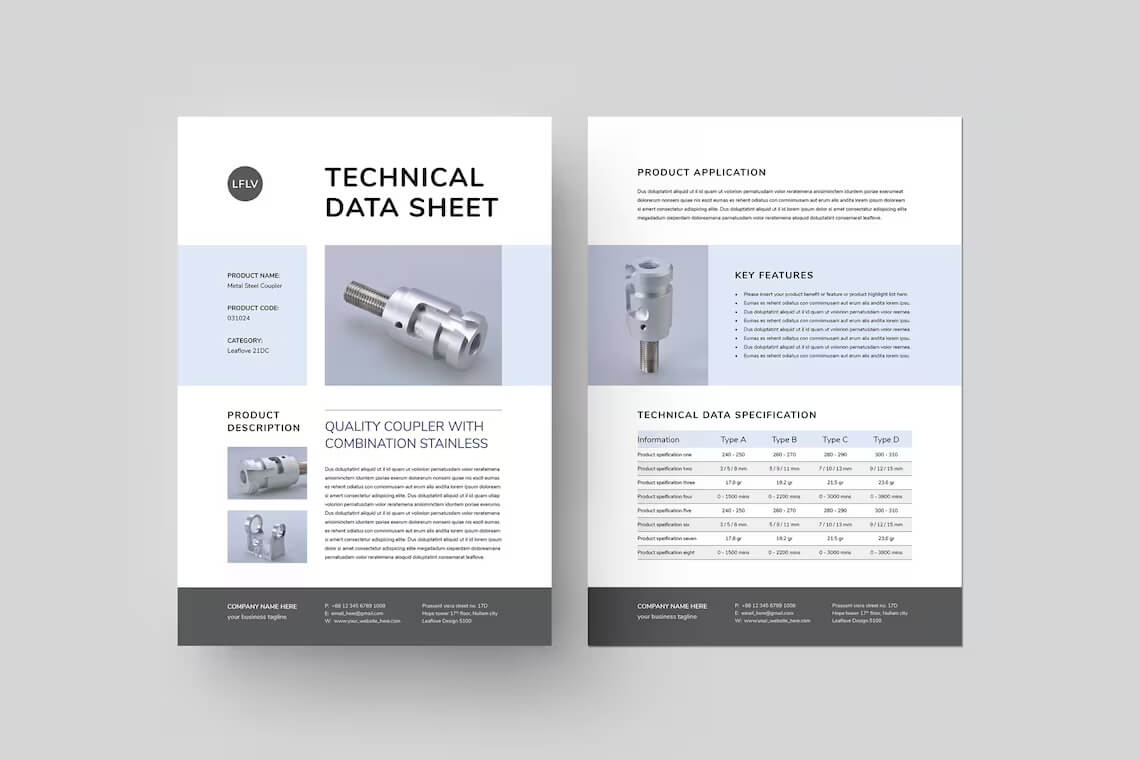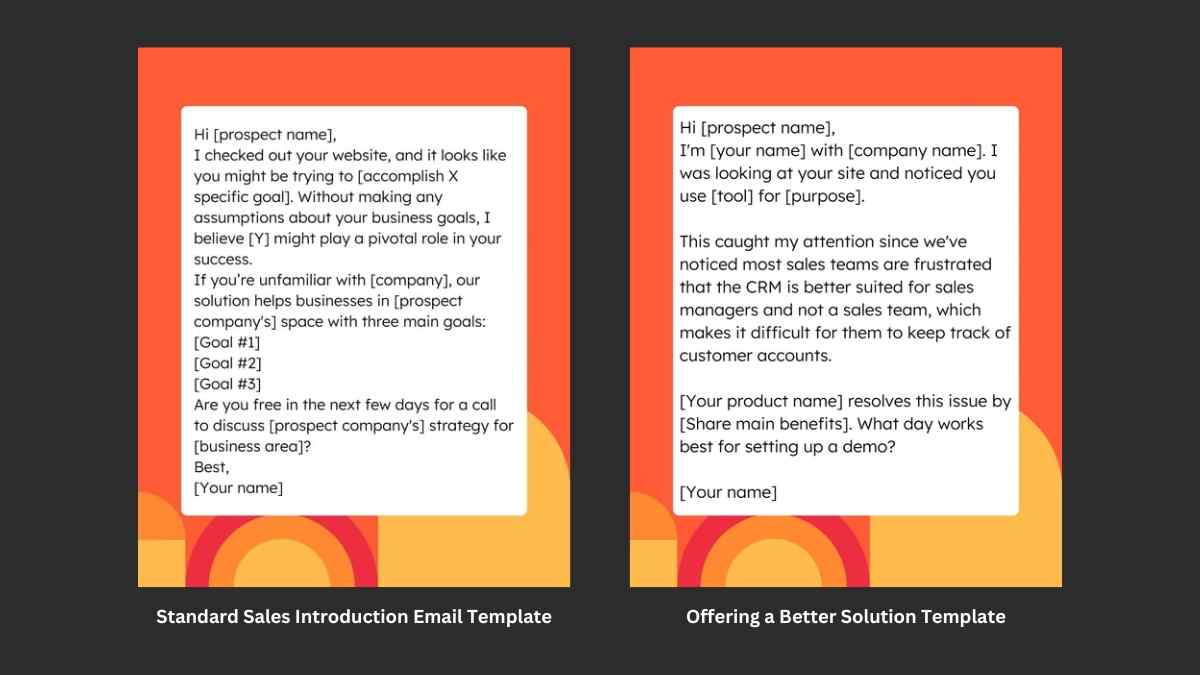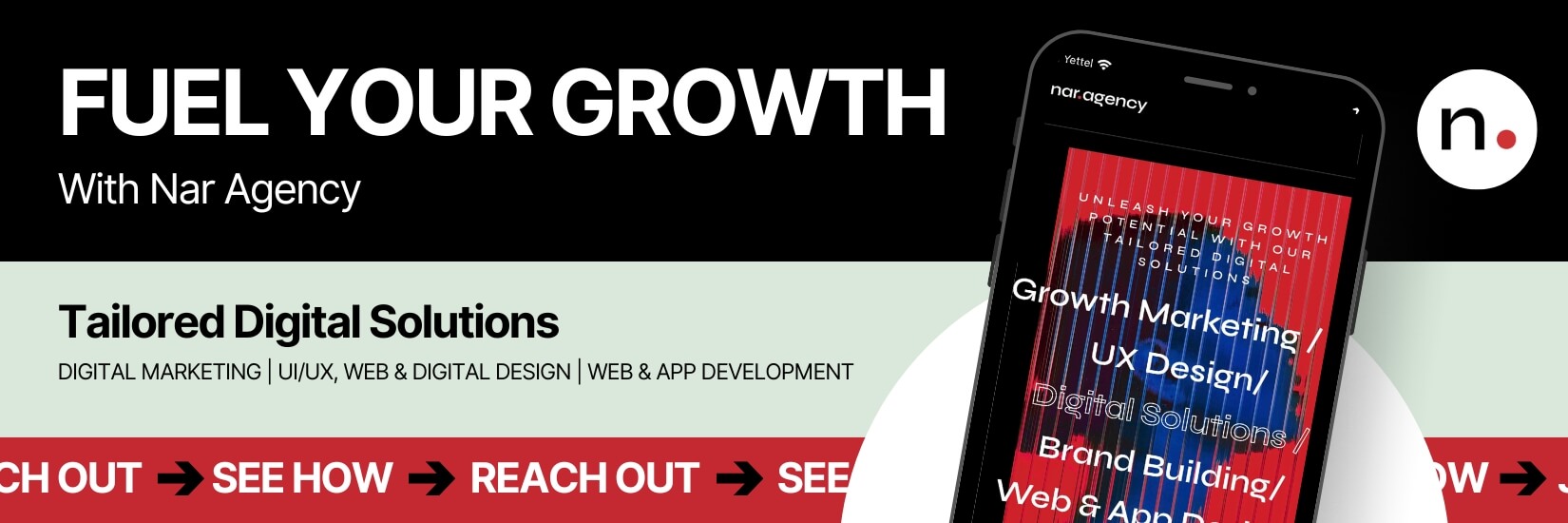Table of Contents
Sales enablement materials are often treated as an afterthought – something that’s quickly thrown together to check a box. But what if investing time and effort into crafting high-impact enablement content could be the key to unlocking your sales team’s true potential?
Picture this
Your sales reps walk into every client meeting armed with persuasive, informative, and visually compelling materials that showcase your product's value. They confidently navigate tough questions and objections, thanks to the comprehensive battlecards and FAQs you've provided. And when it comes time to close the deal, they have a library of case studies and testimonials that prove your solution's worth.
That’s the power of well-designed sales enablement materials. They’re not just documents; they’re strategic assets that can accelerate your sales cycle, boost conversion rates, and ultimately drive revenue growth.
In this guide, we’ll take a deep dive into the world of sales enablement content. We’ll explore the key types of materials your team needs, share best practices for creating them, and reveal proven strategies for integrating them into your sales process. By the end, you’ll have a actionable blueprint for developing a sales enablement toolkit that empowers your team and impresses your customers.
So, let’s get started on this journey to sales enablement excellence!
What are Sales Enablement Materials?
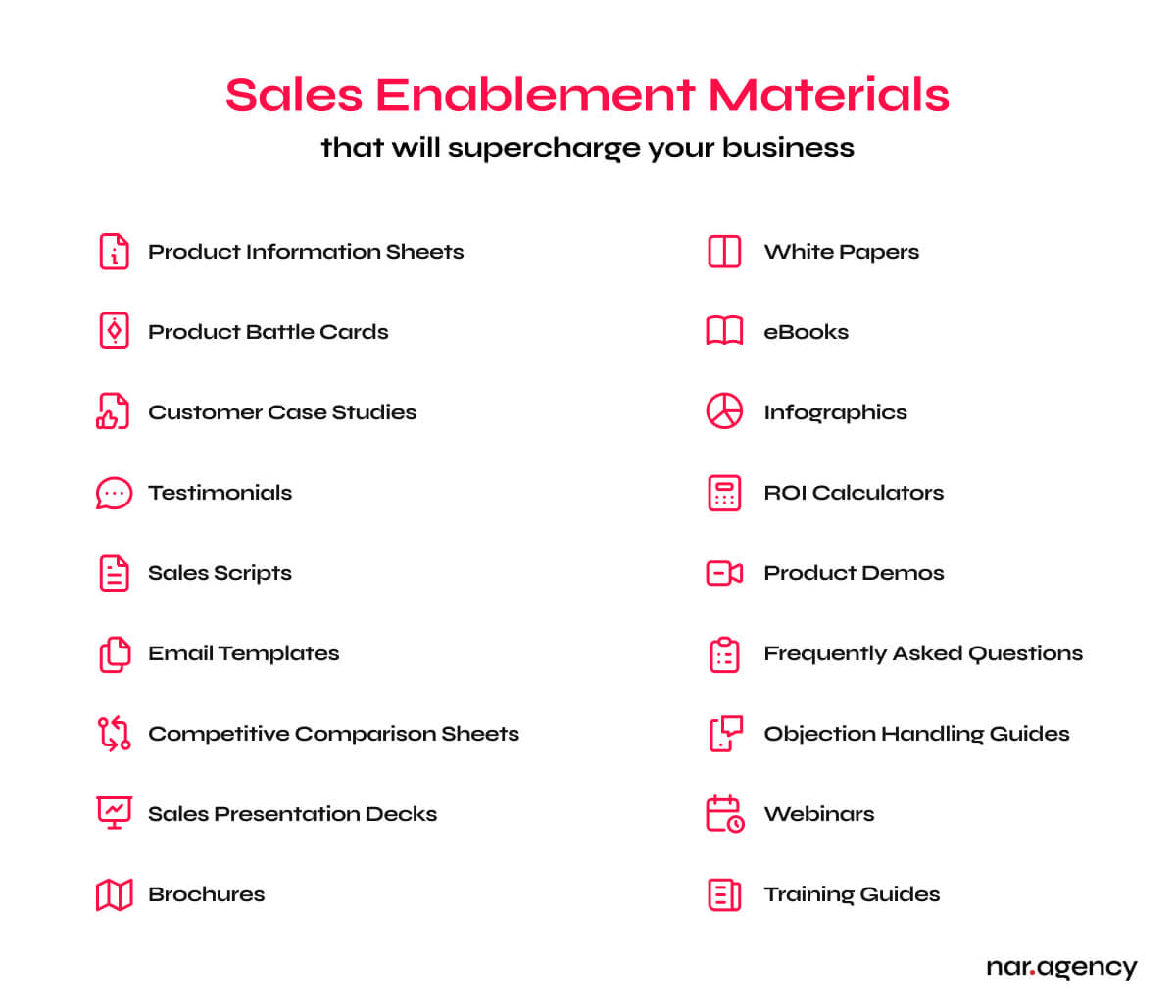
Sales enablement materials are a collection of resources designed to support your sales team throughout the customer journey. These materials arm your reps with the information, insights, and tools they need to effectively engage prospects, overcome objections, and ultimately close more deals.
But sales enablement materials are more than just a bunch of random documents – they’re strategic assets that, when designed and utilized effectively, can have a profound impact on your sales performance. By providing your team with the right resources at the right time, you can:
- Improve the consistency and quality of sales conversations
- Increase reps' confidence and credibility in front of prospects
- Accelerate the sales cycle by addressing common questions and concerns upfront
- Boost conversion rates and revenue by enabling reps to articulate your value proposition more effectively
In short, sales enablement materials are the fuel that powers your sales engine. They ensure that your reps are equipped with the knowledge, skills, and resources they need to succeed in today’s landscape.
But to truly move the needle, you need to understand the different types of materials available, and how to create and deploy them for maximum impact. In the next section, we’ll dive into the essential components of a winning sales enablement toolkit.
Types of Sales Enablement Materials
Not all sales enablement materials are created equal. Each type serves a specific purpose and plays a crucial role in supporting your sales team throughout the customer journey. Let’s take a closer look at the essential pieces of your sales enablement toolkit:
1. Product Information Sheets
These comprehensive documents provide a deep dive into your product’s features, benefits, and technical specifications. They serve as a valuable reference for sales reps, enabling them to answer detailed questions and provide prospects with the information they need to make informed decisions.
Example: A prospect requests more information about your product’s integration capabilities. With a detailed product information sheet, your sales rep can quickly provide the necessary details, demonstrating their knowledge and building trust with the prospect.
2. Product Battle Cards
These concise, tactical documents arm your sales reps with quick, targeted talking points and responses to common objections for specific competitor matchups. Designed to be used in real-time during sales conversations, battle cards provide “attack” and “defend” strategies that help reps effectively counter competitor claims and highlight your unique strengths.
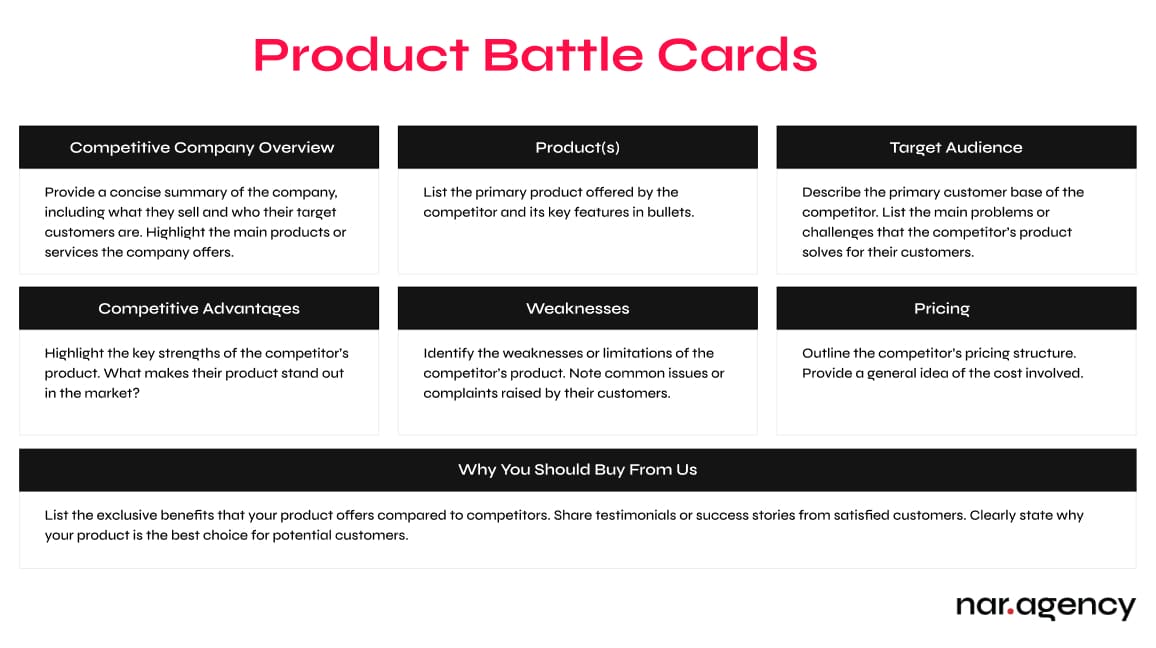
Scenario: During a sales call, a prospect mentions that they’re considering a competitor’s solution because of a specific feature. The sales rep quickly pulls up the relevant battlecard and highlights how your product not only offers a similar feature but also provides additional benefits and superior performance in that area. This targeted response helps the rep regain control of the conversation and emphasize your unique value proposition.
3. Customer Case Studies
Nothing builds trust and credibility like real-world success stories. Case studies showcase how your solution has helped customers overcome challenges, achieve their goals, and drive tangible results. They provide powerful social proof that can sway even the most skeptical prospects.
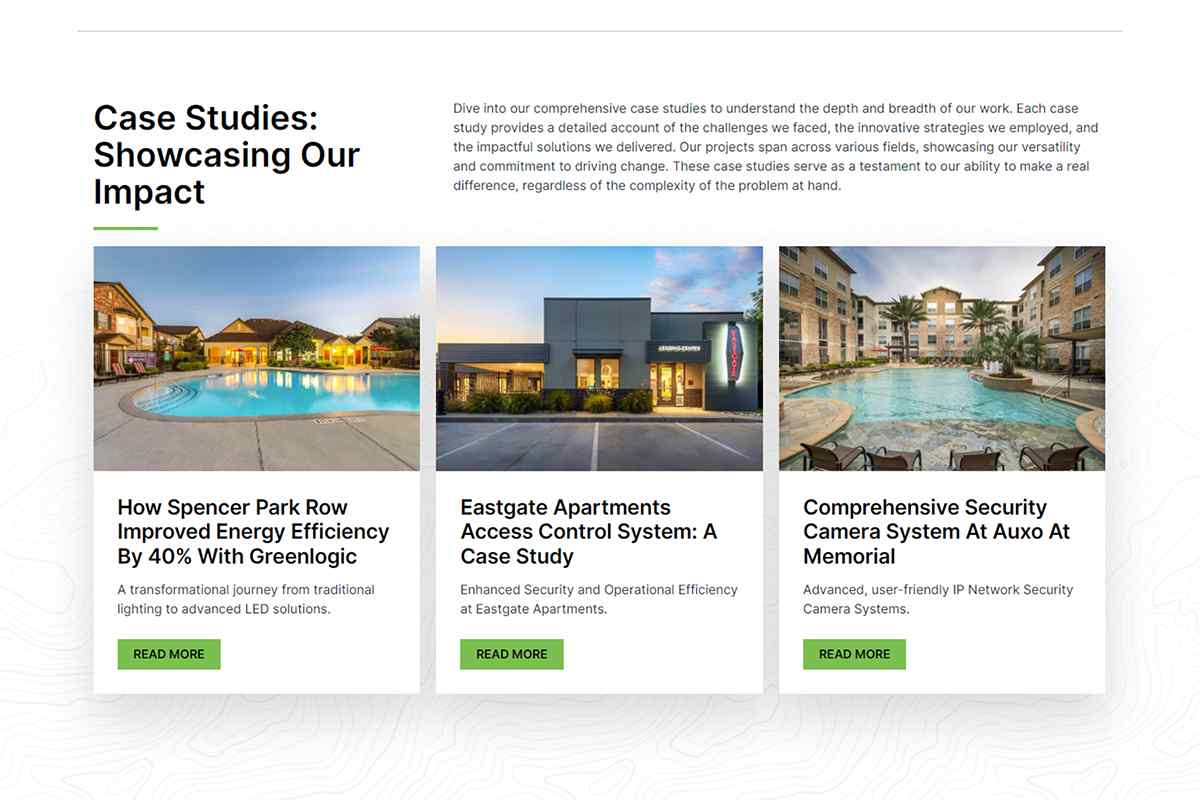
Example: A prospect is unsure if your solution can address their specific pain points. By sharing a relevant case study highlighting how a similar customer achieved success with your product, your sales rep can demonstrate your solution’s effectiveness and move the deal forward.
4. Testimonials and Customer Testimonial Videos
Testimonials are powerful social proof that can significantly influence prospects’ decision-making process. These short, persuasive statements from satisfied customers help build trust, credibility, and confidence in your solution.
Written testimonials can be strategically placed on your website, sales collateral, and marketing materials to reinforce your value proposition and showcase real-world success stories.
Customer testimonial videos take this concept a step further by providing an engaging, authentic way to share customer experiences. These videos help humanize your brand and create an emotional connection with prospects, as they can see and hear directly from people who have benefited from your solution.

Example: A prospect is in the late stages of the decision-making process but expresses some lingering concerns about your solution’s effectiveness. By sharing a compelling testimonial video featuring a customer in a similar industry or with comparable challenges, your sales rep can help alleviate those concerns and demonstrate the tangible results your solution delivers.
5. Sales Scripts
Well-crafted sales scripts provide a solid foundation for reps to structure their verbal conversations, ensuring they effectively communicate your product’s key benefits and value proposition. These scripts serve as a starting point that reps can customize based on each prospect’s specific needs and pain points.

Scenario: A new sales rep is struggling to effectively communicate your product’s key benefits during discovery calls. By providing them with a well-crafted sales script that highlights your unique selling points and includes guidance on active listening and questioning techniques, you can help them quickly improve their pitch and start having more impactful conversations with prospects.
6. Email Templates
Proven email templates help reps craft compelling, persuasive written communication that drives prospects to take action.
These templates provide a framework for reps to follow, ensuring they include key elements like a strong subject line, personalized opening, clear value proposition, and specific call-to-action.
Example: A sales rep needs to follow up with a prospect after a productive discovery call. By using a well-designed email template that reinforces the key points discussed on the call and includes a clear next step, the rep can maintain momentum and keep the deal moving forward.
7. Competitive Comparison Sheets
These comprehensive documents provide a detailed, side-by-side analysis of your solution against multiple competitors. Diving deep into feature comparisons, pricing breakdowns, and value propositions, these sheets enable prospects to thoroughly assess their options and make informed decisions. They are often used in the research and consideration stages of the sales cycle to support a more in-depth evaluation of competing solutions.
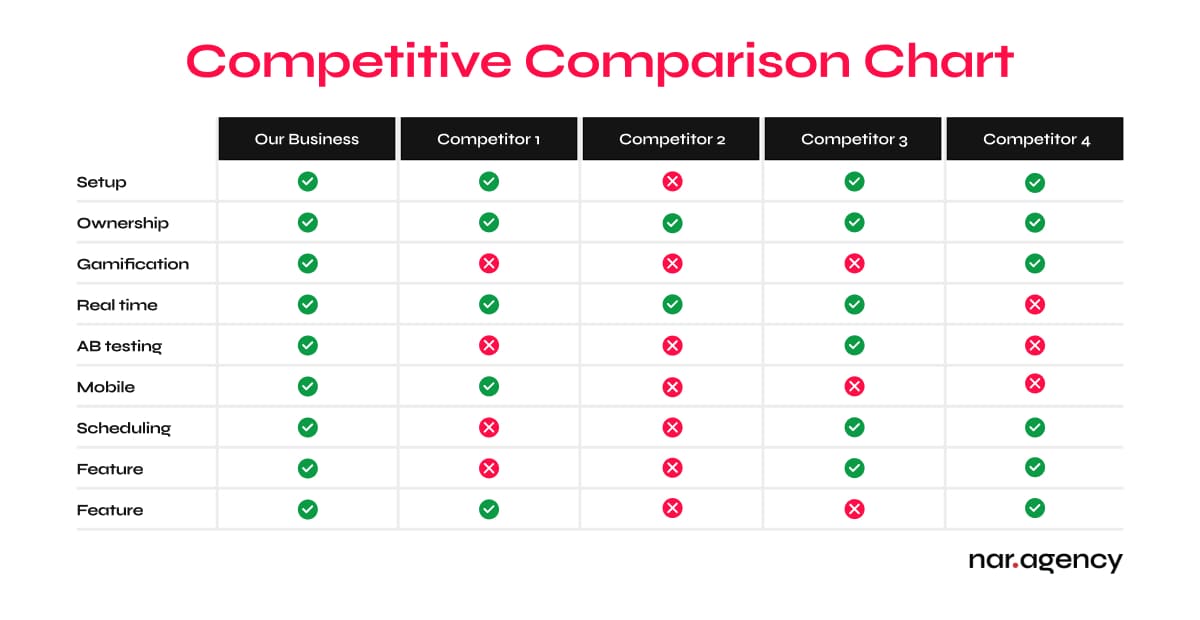
Example: A prospect requests a detailed breakdown of how your solution compares to two key competitors across multiple dimensions, such as pricing, feature sets, integrations, and customer support. The sales rep sends over a comprehensive competitive comparison sheet that provides a clear, side-by-side analysis of all three solutions. This enables the prospect to thoroughly evaluate their options and make an informed decision based on their specific needs and priorities.
8. Sales Presentation Decks
A well-crafted presentation deck is a powerful tool for engaging prospects and bringing your solution to life. It should tell a compelling story, showcase your product’s value, and include interactive elements that encourage discussion and discovery.
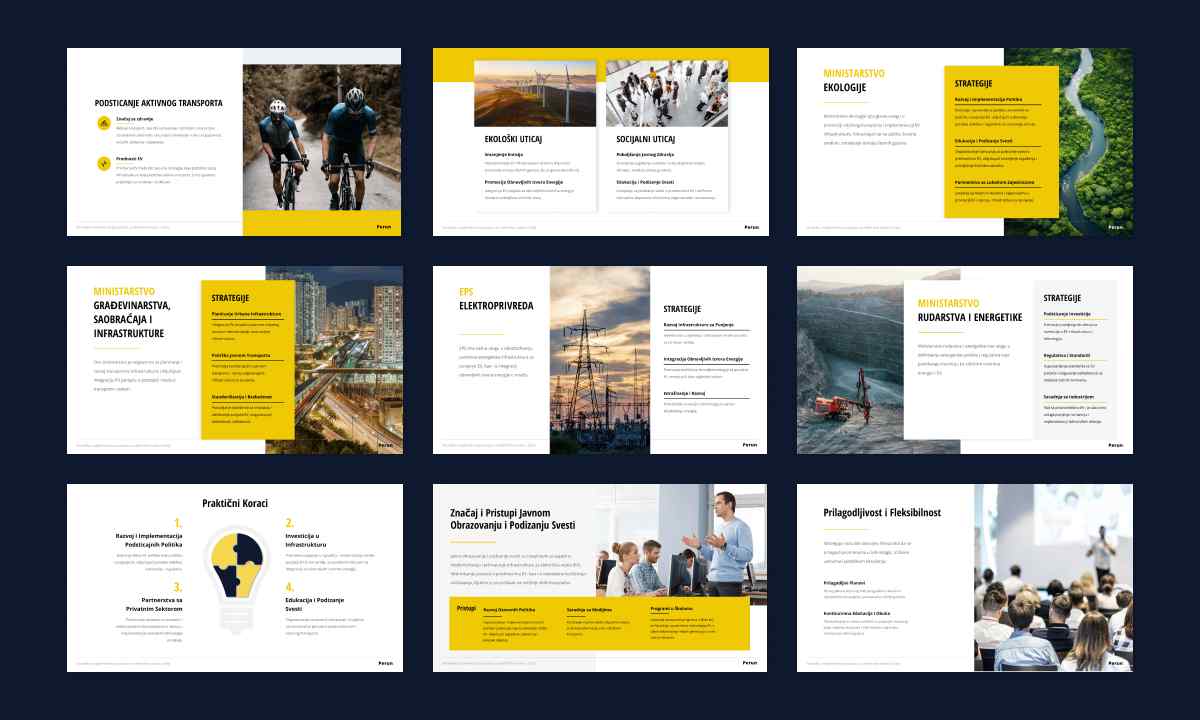
Scenario: Your sales rep is preparing for a critical presentation to a target account’s decision-makers. With a visually compelling and persuasive sales deck, they can effectively communicate your solution’s value proposition, address key concerns, and drive the deal closer to closing.
9. Brochures
Brochures are versatile sales enablement materials that provide a concise, visually appealing overview of your company, products, or services. They serve as a valuable leave-behind or follow-up resource after initial sales conversations, helping prospects remember key points and share information with other decision-makers.
Effective brochures should have a clear structure, compelling headlines, and a balance of text and visual elements. They should highlight your unique value proposition, key benefits, and calls-to-action, encouraging prospects to take the next step in the sales process.
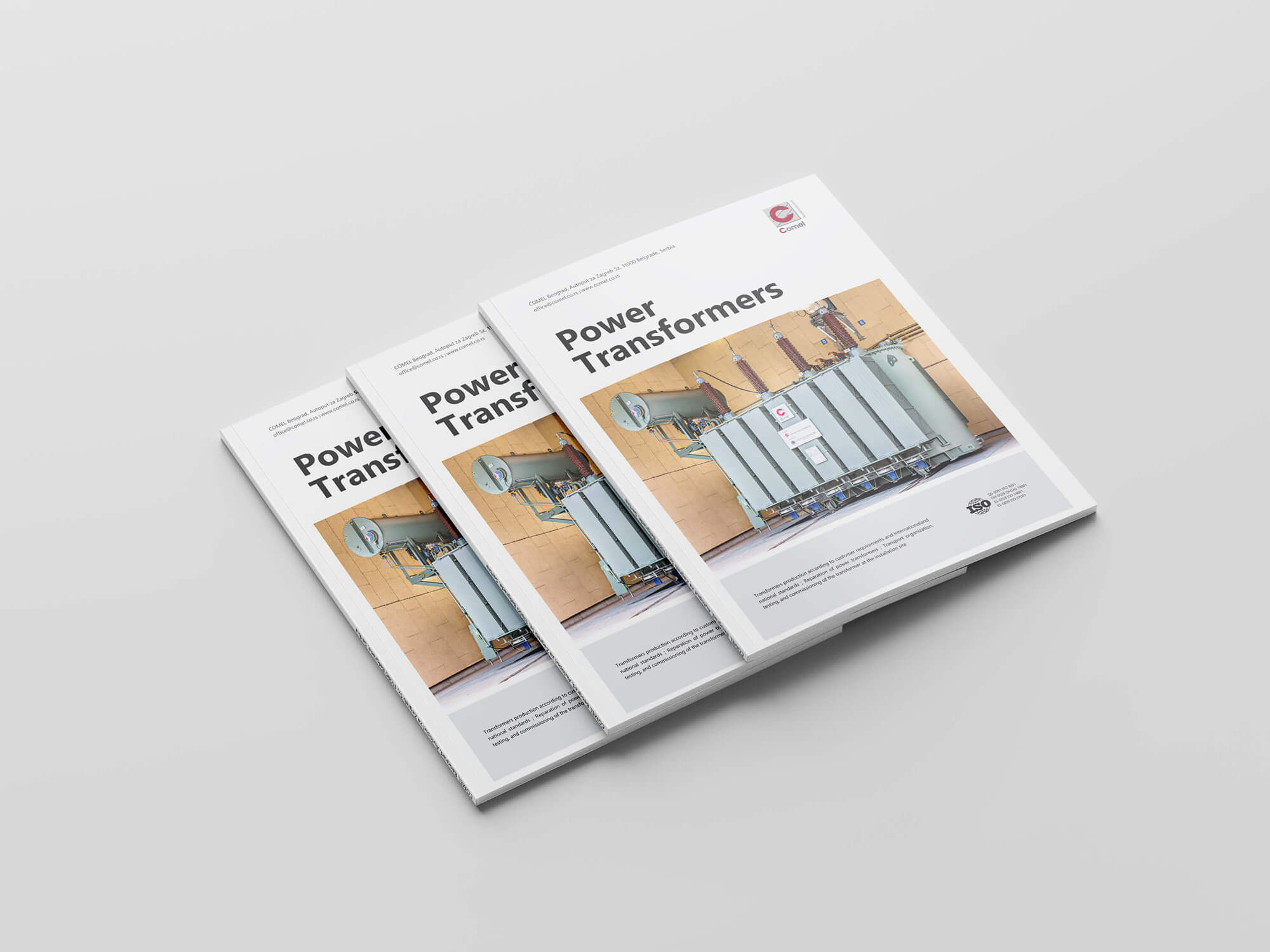
Example: After an initial discovery call, a prospect requests more information about your solution to share with their team. By sending a well-designed brochure that summarizes your key selling points, case studies, and next steps, your sales rep can keep your solution top-of-mind and make it easier for the prospect to advocate for your offering internally.
10. White Papers
White papers are in-depth, authoritative reports that educate prospects about a specific topic, challenge, or solution. They are particularly effective for B2B sales, as they demonstrate your company’s expertise, thought leadership, and ability to solve complex problems.
These long-form content pieces typically include a mix of research, data, and analysis, providing valuable insights and recommendations that help prospects make informed decisions. White papers can be used throughout the sales cycle, from generating initial interest to nurturing leads and supporting the final decision-making process.
Example: A prospect is evaluating multiple solutions to a complex business challenge. By sharing a white paper that thoroughly explores the issue and presents your solution as a comprehensive, data-backed approach, your sales rep can differentiate your offering and position your company as a trusted expert in the field.
11. eBooks
eBooks are another form of long-form content that educate and engage prospects. They often cover broader topics than white papers and tend to be more visually oriented, with a focus on design, readability, and storytelling.
eBooks can be used as lead magnets to attract new prospects, or as valuable resources to nurture existing leads and guide them through the sales funnel. By providing actionable insights, best practices, and real-world examples, eBooks help establish your company as a go-to resource and trusted advisor in your industry.
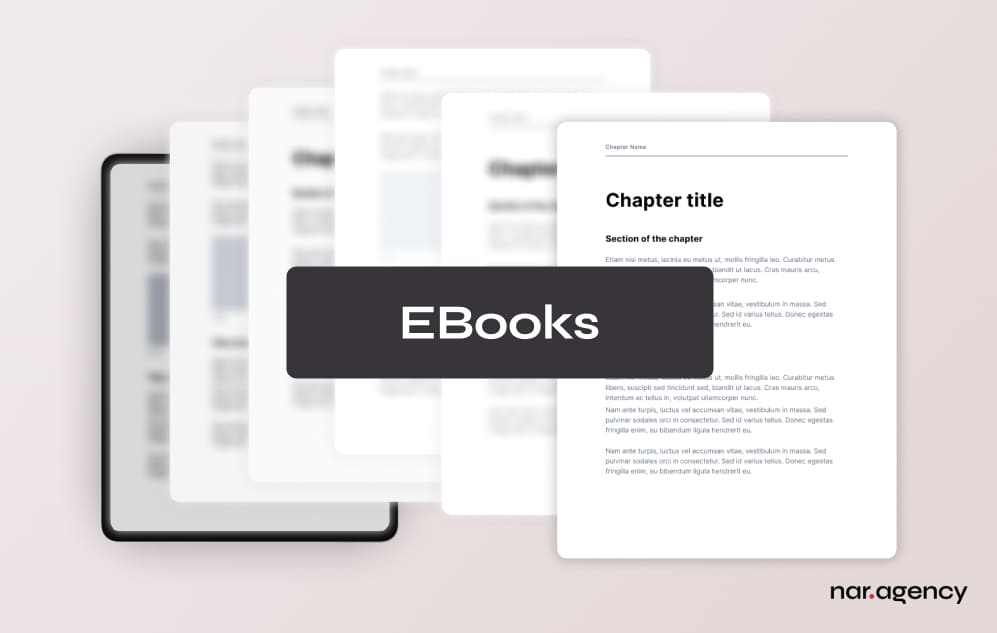
Example: A prospect downloads an eBook from your website on a topic related to their business challenges. By providing valuable, relevant content upfront, you can build trust and credibility with the prospect, making them more receptive to a sales conversation when your rep reaches out to discuss how your solution can help address their specific needs.
12. Infographics
Infographics are visual representations of information, data, or knowledge designed to present complex topics quickly and clearly. They are highly shareable and can be a powerful tool for engaging prospects, simplifying complex ideas, and reinforcing your brand’s expertise.
Sales reps can use infographics throughout the sales process to educate prospects, break down complex topics, and provide a compelling visual aid during presentations or conversations. They can also be used in social media, email campaigns, and on your website to attract and engage potential customers.
Example: A sales rep is trying to explain a complex feature of your product to a prospect. By sharing an infographic that visually breaks down the feature’s components, benefits, and use cases, the rep can make the information more digestible and memorable, helping the prospect better understand the value of your solution.
13. ROI calculators
ROI (Return on Investment) calculators are interactive tools that help prospects estimate the potential financial impact of your solution on their business. These calculators typically allow users to input their specific data, such as current costs, expected savings, or revenue projections, and then generate a personalized ROI report.
ROI calculators are particularly valuable in the later stages of the sales cycle, as they help prospects build a strong business case for investing in your solution. By demonstrating the tangible financial benefits of your offering, ROI calculators can help overcome objections, secure buy-in from key stakeholders, and ultimately drive more conversions.
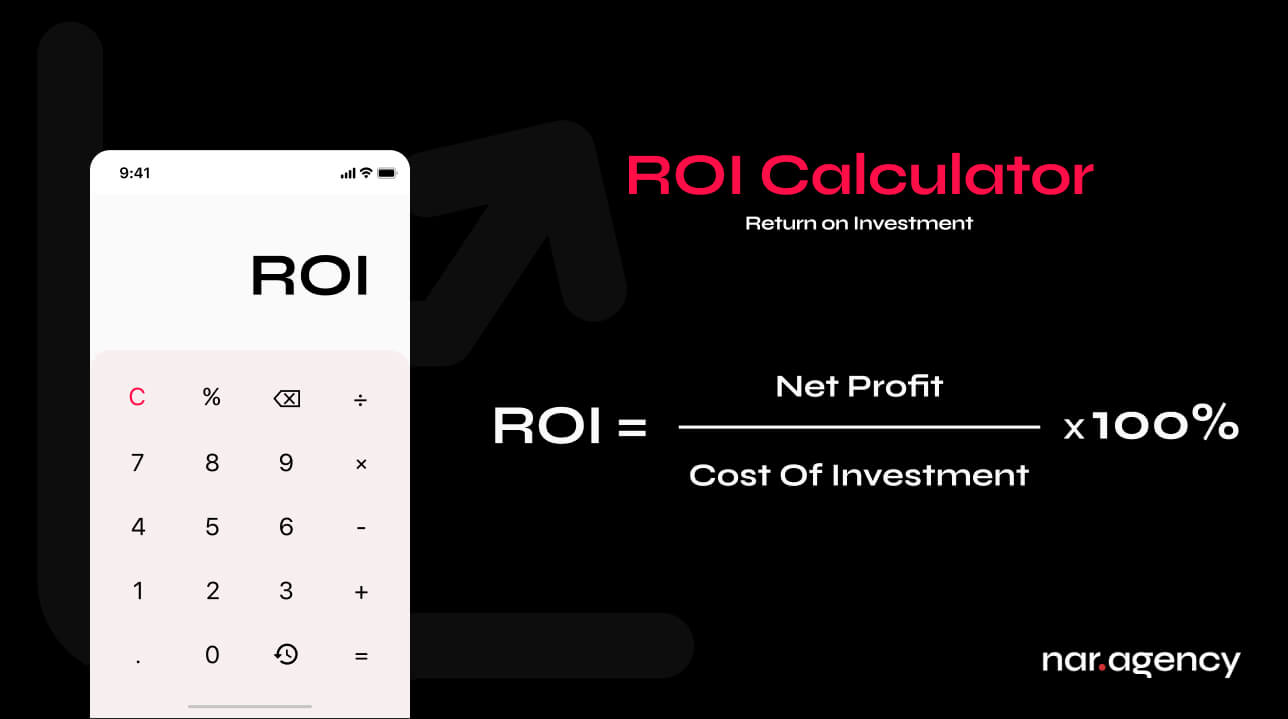
Example: A prospect is interested in your solution but is unsure if the investment will pay off. By providing an ROI calculator on your website or as part of your sales collateral, you enable the prospect to input their specific data and see a clear projection of the potential return on investment. This personalized, data-driven approach can help build confidence in your solution and move the prospect closer to making a purchase decision.
14. Product Demos
Product demos are interactive presentations that showcase your product’s features, functionality, and user experience. They can be delivered live, either in-person or via video conferencing, or as pre-recorded videos that prospects can access on-demand.
Effective product demos are tailored to the specific needs and interests of each prospect, highlighting how your solution can solve their unique challenges and deliver value to their business. They should be engaging, informative, and focused on the benefits rather than just the features.

Example: A prospect expresses interest in your solution but wants to see it in action before making a decision. By providing a personalized product demo that showcases how your solution can address their specific pain points and integrate with their existing systems, your sales rep can build trust, demonstrate your product’s value, and move the prospect closer to a purchase.
These three types of sales enablement materials - infographics, ROI calculators, and product demos - can be powerful tools for engaging prospects, communicating complex information, and demonstrating the value of your solution. By incorporating them into your sales process and making them easily accessible to your sales team, you can empower your reps to have more effective conversations and ultimately drive more conversions.
15. Frequently asked questions (FAQs)
FAQs are a collection of common questions and concerns that prospects typically have about your product, service, or industry, along with clear, concise answers. They serve as a valuable resource for both prospects and sales reps, as they address key issues upfront and help streamline the sales process.
By anticipating and addressing common questions, FAQs enable sales reps to provide quick, accurate responses and demonstrate their expertise. They also help prospects find the information they need more easily, which can improve their experience and build trust in your brand.
Example: A prospect is considering your solution but has several questions about implementation, integration, and support. By directing them to a comprehensive FAQ page or document, your sales rep can provide instant answers to their questions, alleviating concerns and moving the conversation forward.
16. Objection Handling Guides
Objection handling guides are internal resources that equip sales reps with effective strategies and talking points for addressing common sales objections. These guides outline the most frequently encountered objections, such as concerns about price, timing, or product fit, and provide proven techniques for overcoming them.
By using objection handling guides, sales reps can confidently navigate challenging conversations, reframe objections as opportunities, and keep deals moving forward. These guides also help ensure that all reps are using consistent, effective messaging when addressing objections.
Example: During a sales call, a prospect expresses concern about the cost of your solution. The sales rep refers to the objection handling guide and finds a series of talking points that highlight the long-term value and ROI of your offering. By using these proven strategies, the rep is able to address the prospect’s concerns effectively and keep the deal on track.
17. Webinars
Webinars are online seminars or workshops that educate prospects about a specific topic, industry trend, or solution. They are an engaging, interactive format for sharing valuable content, demonstrating thought leadership, and generating leads.
Sales reps can use webinars in various ways throughout the sales process. They can invite prospects to upcoming webinars to nurture relationships and provide value, or they can share recordings of past webinars to address specific questions or concerns. Webinars can also be used to showcase customer success stories, provide product demos, or offer training and support.

Example: A prospect is interested in learning more about how your solution can help them achieve a specific business goal. Your sales rep invites them to an upcoming webinar that showcases customer success stories and provides actionable insights on the topic. By attending the webinar, the prospect gains valuable knowledge and sees firsthand how your solution has helped others in similar situations, moving them closer to a purchase decision.
18. Training Guides and Resources
Investing in your sales team’s development is key to driving long-term success. Training guides and resources, such as e-learning modules, videos, and quizzes, help your reps build the skills and knowledge they need to excel in their roles and deliver value to customers.

Example: A sales rep is struggling to effectively navigate a specific stage of the sales process. By completing a targeted training module on that topic, they can acquire the necessary skills and strategies to overcome challenges and improve their performance.
Unlock Your Sales Team’s Full Potential
Ready to equip your team with high-impact sales enablement materials?
Our experts are here to help.
From strategy and design to copywriting and distribution, we’ll create a customized toolkit that empowers your reps and drives results.
By equipping your sales team with these essential materials and understanding how each one can be leveraged to address specific selling situations, you'll empower them to have more productive conversations, build stronger relationships with prospects, and ultimately close more deals.
In the next section, we’ll explore best practices for designing and formatting these resources to maximize their impact.
Creating Effective Sales Enablement Materials

Crafting sales enablement materials that truly empower your team and drive results requires a strategic approach. Here are three key areas to focus on:
1. Identifying Key Information to Include
When creating sales enablement materials, it’s crucial to include the information that matters most to your sales team and your prospects. Start by gathering insights from your top-performing reps and analyzing successful sales interactions to identify the key talking points, data, and resources that move the needle.
Some essential elements to consider include:
- Unique value proposition and key differentiators
- Product features, benefits, and use cases
- Pricing and packaging details
- Customer success stories and testimonials
- Answers to common objections and FAQs
For example, HubSpot, a leading inbound marketing and sales platform, creates comprehensive sales enablement materials that focus on their unique value proposition and key differentiators. By highlighting their all-in-one platform, powerful integrations, and exceptional customer support, they equip their sales team with the information needed to effectively communicate their competitive advantages and win more deals.
2. Best Practices for Design and Formatting
The way your sales enablement materials look and feel can have a big impact on how effectively they’re used by your team and received by prospects. Follow these best practices to ensure your materials are engaging, easy to navigate, and visually compelling:
- Use a clean, consistent visual design that aligns with your brand guidelines
- Break up content into clear sections with headings and subheadings
- Use bullet points, charts, and graphics to make information easy to scan and digest
- Incorporate plenty of white space to avoid overwhelming readers
- Make materials easily accessible and shareable across devices and platforms
A great example of well-designed sales enablement materials comes from Salesforce, the global leader in CRM. Their sales enablement content is visually stunning, with a consistent brand design, clear hierarchy of information, and ample use of graphics and white space. As a result, their sales team can easily navigate and share these materials, leading to more productive conversations with prospects.
3. Ensuring Materials Stay Up-to-Date and Relevant
Sales enablement materials are only effective if they’re accurate and up-to-date. Establish a regular review and update process to ensure your materials always reflect the latest product information, market trends, and customer insights.
Consider assigning ownership of specific materials to subject matter experts within your organization, and establish clear guidelines for when and how updates should be made. Use version control and document management tools to ensure your team always has access to the most current, approved versions of each resource.
Industry research supports the importance of keeping sales enablement materials current. A study by CSO Insights found that organizations with a formal process for updating sales content see a 21% improvement in win rates compared to those without a process.
By focusing on these three key areas - identifying essential information, following design best practices, and keeping materials up-to-date - you'll be well on your way to creating sales enablement materials that truly move the needle.
Next up, let’s explore how to effectively distribute these materials to your team and integrate them into your sales process for maximum impact.
Distributing and Utilizing Sales Enablement Materials
Creating high-impact sales enablement materials is just the first step – to see results, you need to ensure your content reaches your target audience and is utilized effectively by your sales team.
Here’s how:
1. Sharing Materials with Your Sales Team
Make it easy for your sales reps to access and use the materials you create by centralizing them in a single, searchable repository. Use a sales enablement or content management platform that allows reps to quickly find the resources they need based on factors like buyer persona, sales stage, or product line.
Provide regular training and communication to ensure reps are aware of new materials and updates, and gather their feedback to continuously improve the resources you provide.
2. External Distribution Channels
To maximize the reach and impact of your sales enablement materials, it’s important to distribute them through various external channels where your target audience is active. Some effective distribution methods include:
- Hosting materials on a dedicated resource center or library on your website
- Sharing content via your company's social media profiles and relevant industry groups
- Distributing content through targeted email marketing campaigns
- Leveraging paid advertising on platforms like Google, LinkedIn, or Facebook to promote your materials
- Syndicating content through partner websites, industry publications, or guest blog posts
By diversifying your distribution channels, you can reach a wider audience, drive more traffic to your sales enablement assets, and ultimately generate more qualified leads for your sales team.
3. Integrating Materials into Your Sales Process
To maximize the impact of your sales enablement materials, it’s essential to integrate them into your overall sales process. Map out your buyer’s journey and identify key touchpoints where specific materials can be used to educate, persuade, and move prospects forward.
For example, you might use product overview sheets in the early stages of the sales cycle to generate interest, case studies in the consideration phase to build trust, and ROI calculators in the decision stage to drive home the value of your solution.
4. Tracking Usage and Effectiveness
To continually optimize your sales enablement materials, you need visibility into how they’re being used and what impact they’re having on key metrics like conversion rates, deal size, and sales cycle length.
Use analytics and reporting capabilities within your sales enablement or CRM platform to track material usage, gather feedback from reps and prospects, and correlate asset engagement with sales performance. Use these insights to identify top-performing assets, fill content gaps, and refine your overall sales enablement strategy.
By following these best practices for distributing, integrating, and tracking your sales enablement materials, you'll be able to maximize their impact and drive better results for your team.
Now, let’s turn our attention to one final piece of the puzzle – optimizing your sales enablement materials for search engines to increase their reach and impact.
Optimizing Sales Enablement Materials for SEO
In addition to sharing your sales enablement materials with your internal team and distributing them through external channels, optimizing them for search engines can further expand their reach and impact.
By making your materials discoverable through search, you can attract new prospects, establish thought leadership, and drive additional traffic to your website.
Here are a few key strategies to keep in mind:
1. Keyword Research and Targeting
Start by identifying the keywords and phrases your ideal customers are using to search for information related to your products, services, and industry. Use tools like Google Keyword Planner or Ahrefs to research keyword volume, difficulty, and relevance.
Partner with Nar Agency
Need help optimizing your sales enablement content for search?
Our team of SEO experts will help you identify the right keywords, optimize your content structure, and drive measurable results.
Once you have a list of target keywords, incorporate them naturally into your sales enablement materials – including titles, headings, subheadings, and body content. But avoid keyword stuffing, which can actually hurt your SEO performance.
For startups looking to leverage SEO for growth, check out this SEO for startups guide.
2. Optimizing Titles, Descriptions, and Content
In addition to incorporating keywords, make sure your sales enablement materials are structured in a way that’s easy for search engines to understand and index.
This includes:
- Using clear, descriptive titles that accurately reflect the content of each asset
- Including meta descriptions that summarize the key points and value of each resource
- Structuring content with headings, subheadings, and bullet points to make it easy to scan and navigate
- Optimizing images with descriptive file names, alt text, and captions
- Ensuring content is unique, valuable, and relevant to your target audience
3. Leveraging Internal Linking
Finally, don’t forget the power of internal linking to boost the SEO value of your sales enablement materials. By linking related assets together – such as linking a product overview sheet to a relevant case study or video demo – you can help search engines understand the relationships between your content and pass authority between pages.
To learn more about internal linking best practices, read this in-depth guide.
You can also use internal linking to guide prospects through the buyer’s journey, directing them to the most relevant resources based on their stage in the sales cycle.
By optimizing your sales enablement materials for SEO and aligning this effort with your external distribution strategy, you can maximize their visibility, reach, and impact – not just with your internal team, but with new prospects and customers as well
Conclusion
Sales enablement materials are a critical component of any high-performing sales organization. By equipping your reps with the right resources at the right time, you can empower them to have more effective conversations, build stronger relationships, and ultimately close more deals.
But creating truly impactful sales enablement materials requires a strategic, thoughtful approach. By focusing on identifying key information, following best practices for design and formatting, keeping materials up-to-date, and integrating them into your sales process, you can create a powerful toolkit that drives real results.
And by optimizing your materials for search engines, you can extend their reach and impact even further – attracting new prospects, establishing thought leadership, and driving more traffic to your website.
So if you haven’t already, now is the time to invest in creating high-quality sales enablement materials. Use the strategies and best practices outlined in this guide to develop a comprehensive toolkit that empowers your team and drives long-term success.
And remember – sales enablement is an ongoing process, not a one-time event. Continuously gather feedback, track performance, and refine your approach to ensure your materials are always aligned with the evolving needs of your team and your customers.
With the right sales enablement materials in place, there’s no limit to what your team can achieve. So get started today – and watch your sales soar
Share :

